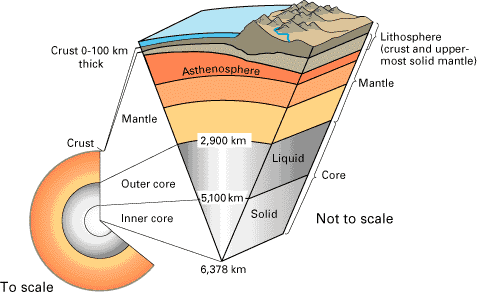EXPLORE: Tectonic Plates & Earth's Structure (BrainPop)
| Site: | Mountain Heights Academy OER |
| Course: | Earth Science Q2 |
| Book: | EXPLORE: Tectonic Plates & Earth's Structure (BrainPop) |
| Printed by: | Guest user |
| Date: | Thursday, 24 July 2025, 9:07 PM |
1. What is a Tectonic Plate?

A tectonic plate (also called a lithospheric plate) is a massive, irregularly shaped slab of solid rock, generally composed of both continental and oceanic lithosphere. Plate size can vary greatly, from a few hundred to thousands of kilometers across; the Pacific and Antarctic Plates are among the largest. Plate thickness also varies greatly, ranging from less than 15 km for young parts of the ocean to about 200 km or more for ancient parts of the ocean (for example, the interior parts of North and South America).
How do these massive slabs of solid rock float despite their tremendous weight? The answer lies in the composition of the rocks. Continental crust is composed of granitic rocks which are made up of relatively lightweight minerals such as quartz and feldspar. By contrast, oceanic crust is composed of basaltic rocks, which are much denser and heavier. The variations in plate thickness are nature's way of partly compensating for the imbalance in the weight and density of the two types of crust. Because continental rocks are much lighter, the crust under the continents is much thicker (as much as 100 km) whereas the crust under the oceans is generally only about 5 km thick. Like icebergs, only the tips of which are visible above water, continents have deep "roots" to support their elevations.
Most of the boundaries between individual plates cannot be seen, because they are hidden beneath the oceans. Yet oceanic plate boundaries can be mapped accurately from outer space by measurements from GEOSAT satellites. Earthquake and volcanic activity is concentrated near these boundaries. Tectonic plates probably developed very early in the Earth's 4.6-billion-year history, and they have been drifting about on the surface ever since-like slow-moving bumper cars repeatedly clustering together and then separating.
Like many features on the Earth's surface, plates change over time. Those composed partly or entirely of oceanic lithosphere can sink under another plate, usually a lighter, mostly continental plate, and eventually disappear completely. This process is happening now off the coast of Oregon and Washington. The small Juan de Fuca Plate, a remnant of the formerly much larger oceanic Farallon Plate, will someday be entirely consumed as it continues to sink beneath the North American Plate.
Source: http://pubs.usgs.gov/gip/dynamic/tectonic.html (public domain)
2. Earth's Tectonic Plates
Earth's surface is made up of tectonic plates. Tectonic plates are composed of lithosphere, and "float" on top of the asthenosphere. The following screencast introduces the concepts of Earth's interior structure, lithosphere & asthenosphere, continental vs. oceanic plates, and the rate of movement of Earth's tectonic plates.
Sources for images:
www.worldofteaching.com
http://wikimediafoundation.org/wiki/File:Tectonic_plates.png
3. Inside the Earth (BrainPop)

The size of the Earth -- about 12,750 km in diameter--was known by the ancient Greeks, but it was not until the turn of the 20th century that scientists determined that our planet is made up of three main layers: crust, mantle, and core. This layered structure can be compared to that of a boiled egg. The crust, the outermost layer, is rigid and very thin compared with the other two.
Beneath the oceans, the crust varies little in thickness, generally extending only to about 5 km. The thickness of the crust beneath continents is much more variable but averages about 30 km; under large mountain ranges, such as the Alps or the Sierra Nevada, however, the base of the crust can be as deep as 100 km. Like the shell of an egg, the Earth's crust is brittle and can break.